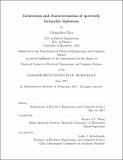| dc.contributor.advisor | Franco N.C. Wong. | en_US |
| dc.contributor.author | Chen, Changchen | en_US |
| dc.contributor.other | Massachusetts Institute of Technology. Department of Electrical Engineering and Computer Science. | en_US |
| dc.date.accessioned | 2017-10-18T14:42:47Z | |
| dc.date.available | 2017-10-18T14:42:47Z | |
| dc.date.copyright | 2017 | en_US |
| dc.date.issued | 2017 | en_US |
| dc.identifier.uri | http://hdl.handle.net/1721.1/111865 | |
| dc.description | Thesis: S.M., Massachusetts Institute of Technology, Department of Electrical Engineering and Computer Science, 2017. | en_US |
| dc.description | This electronic version was submitted by the student author. The certified thesis is available in the Institute Archives and Special Collections. | en_US |
| dc.description | Cataloged from student-submitted PDF version of thesis. | en_US |
| dc.description | Includes bibliographical references (pages 73-77). | en_US |
| dc.description.abstract | Spectrally unentangled biphotons with high single-spatiotemporal-mode purity are highly desirable for many quantum information processing tasks. We generate biphotons with an inferred heralded-state spectral purity of 99%, the highest to date without any spectral filtering, by pulsed spontaneous parametric down-conversion (SPDC) in a custom-fabricated periodically-poled KTiOPO₄ (PPKTP) crystal under extended Gaussian phase-matching conditions. The high purity achieved is made possible by the Gaussian phase-matching function of our custom PPKTP crystal. Without applying spectral filtering and using a standard PPKTP crystal, the highest previously reported purity is 93%. We characterize the joint spectral density of the generated biphoton by converting the spectral content to temporal information via dispersion through a 42-km SMF28 fiber. To characterize the JSD at high spectral resolution and more eciently, we employ a commercially available dispersion compensation module (DCM) with a dispersion equivalent to 100km of standard optical fiber and with an insertion loss of only 2.8 dB. Compared with the typical method of using two temperature-stabilized equal-length fibers that incurs an insertion loss of 20 dB per fiber, the DCM approach achieves high spectral resolution in a much shorter measurement time. We also verify the indistinguishability of the SPDC signal and idler photons via Hong-Ou-Mandel interferometric measurements. The near perfect interference visibility confirms that they are indeed indistinguishable. | en_US |
| dc.description.statementofresponsibility | by Changchen Chen. | en_US |
| dc.format.extent | 77 pages | en_US |
| dc.language.iso | eng | en_US |
| dc.publisher | Massachusetts Institute of Technology | en_US |
| dc.rights | MIT theses are protected by copyright. They may be viewed, downloaded, or printed from this source but further reproduction or distribution in any format is prohibited without written permission. | en_US |
| dc.rights.uri | http://dspace.mit.edu/handle/1721.1/7582 | en_US |
| dc.subject | Electrical Engineering and Computer Science. | en_US |
| dc.title | Generation and characterization of spectrally factorable biphotons | en_US |
| dc.type | Thesis | en_US |
| dc.description.degree | S.M. | en_US |
| dc.contributor.department | Massachusetts Institute of Technology. Department of Electrical Engineering and Computer Science | |
| dc.identifier.oclc | 1005231634 | en_US |
